Determining the Optics of Fancy Shape Diamonds Using ASET
If you are in the market for a round diamond, you may choose to skip this page and jump to the next page. However, if you are shopping for a fancy shape diamond, you need to read this in full and be prepared for a tougher selection process.
There are 2 main reasons why fancies are harder to choose.
Firstly, unlike the popular round diamonds which can be found in almost every jewelry store, fancy cuts aren’t high in demand. This means that stores typically don’t hold a wide selection of fancy cut stones where you can simply and easily find a diamond that matches your requirement.
Secondly, there is a lack of objective cut information presented in grading reports. Most gemological labs do not assign any cut grades to the fancy shapes (with the exception of AGS for top-of-the line princess and cushion cuts) and this makes it extremely difficult for consumers to determine cut quality.
Here’s What a GIA Report for a Fancy Cut Diamond Looks Like
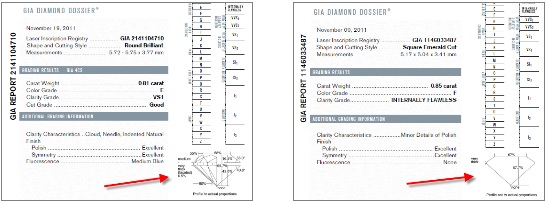
Compare the GIA Dossier Reports for Round Brilliants (Left) and Fancy Shapes (Right).
Did you notice the absence of a cut grade in the report for the fancy shaped diamond? Can you also see that that the measurements for crown and pavilion angles (indicated by red arrow) are also missing?
Using only the limited data on cut proportions, physical dimension measurements and carat weight, it is impossible to tell how a fancy cut diamond would look like in real life based on its grading report.
However, as a general guideline to help you narrow down your initial selections, you can use the tables of recommended proportions for the various shapes as a reference. These tables can be found in the corresponding sections we have written for each individual shape.
For online shoppers, having a magnified image or video to help you visualize the stone’s appearance is a MUST. The same goes for people who intend to make a purchase in a local store. Make sure you perform an inspection with a loupe and pay attention to the outline of the diamond.
Once you are done filtering down your selections, the next most important step is to obtain an ASET image. This will help you determine the optical characteristics and performance of the diamond.
What’s an ASET? (Angular Spectrum Evaluation Technology®)
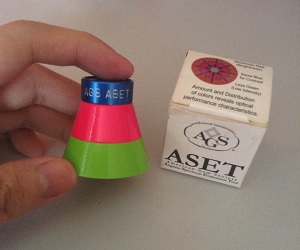
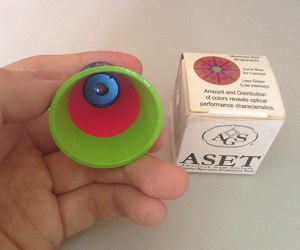
This handheld version of the ASET can be conveniently carried around.
The ASET tool was developed by the American Gem Society and works in a similar fashion as the ideal scope. It is used to demonstrate how a diamond handles and returns light to the observer by using colored bands of red, green, and blue.
The main difference between an ASET and Idealscope lies in how light performance data is being presented. In terms of practical usage, the ASET is predominantly used to determine optical performances for fancy shaped diamonds whereas the IdealScope is utilized for round brilliants.
What Do The Color Bands Represent in an ASET Scope?
Red – Light Return Blue – Adds Contrast Green – Light From Environment White – Light Leakage
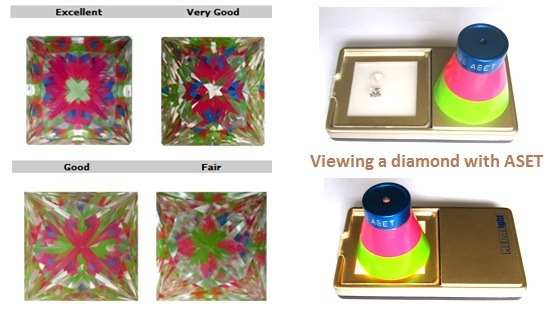
Click here to download a pdf file for the tutorial on the Angular Spectrum Evaluation Tool
To see more examples and reference charts for various diamond shapes, click this link.
Why I Strongly Advise Against Buying Fancy Shapes Locally
To begin with, most local brick and mortar shops do not provide any ASET data or possess an in-house setup that customers can use. The sad fact is, most jewelers do not even understand what diamond cut or light performance really is.
And I can tell you that once you read Beyond4cs.com, you will be more knowledgeable than 90% of jewelers who had been “plying” their trade for years.
Next, you can count yourself super lucky to find a store that can offer 2-3 choices of a particular fancy shape with the right carat weight, color and clarity grading. To put things in perspective, let’s say I’m searching for a 1 carat cushion cut diamond with a color grade between F-H and clarity of VVS1-SI1.
A simple search on James Allen can reveal around 200-300 diamonds to choose from. Can your local shop beat that? Even with that huge amount of possible choices, I sometimes can’t even find a single diamond that meets my standards for cut quality and optical performance.
Ok, let’s say it is your lucky day and the planets happened to aligned together when you make your trip to the local store. Having 2-3 diamonds available to pick from doesn’t mean anything much. The truth is, the majority of fancy shapes are cut to optimize carat weight instead of brilliance. It is highly possible that all 2-3 diamonds available are all of lower cut quality. In other words, it means that you’ll only be making a choice for the “best looking” stone among badly-cut diamonds.
For this reason, I advise you to work with jewelers (either online or offline) who can provide you with the required ASET data and impartial analysis for their inventory. Unless you have a trained eye and know what kind of brilliance and patterns to look out for, shopping without any light performance data is risky.
You Don’t Necessarily Have to Buy an ASET Scope
The handheld version of the ASET scope is a simple and portable device you can carry around. However, the limitations of the device lie in getting a consistent source of lighting when examining diamonds. Having said that, you don’t have to worry about learning how to use the ASET tool if you don’t want to.

Photographs Courtesy of White Flash Inc.

At the end of the day, if you are more comfortable about shopping in a physical store, the other alternative is to invest in your own scope and bring it along with you when viewing diamonds.
Please feel free to contact me if you need a second opinion on your diamond’s ASET or Idealscope data. I do have the necessary experience in correlating light performance to ASET data and can offer you an interpretation for your image.
* Update: Due to popular reader requests, I decided to write a separate post detailing the step by step process of choosing a fancy cut diamond, click here to read it.
And now that we had dealt with the more techy stuff, we are going to touch on some other important shopping tips on the following pages…
Related Articles
Leave A Comment

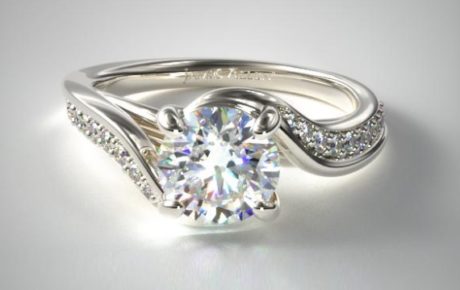
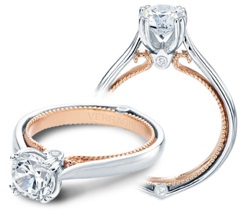
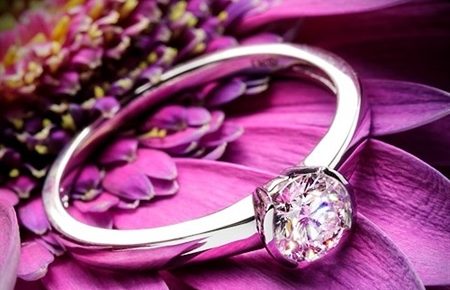
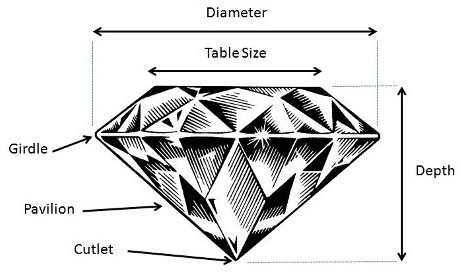









13 Comments
Always loved your articles. So informative!!
I agree with all the things you said here. ut there is one thing I don’t understand. I have been looking at either princess cuts or radiant cuts. if I went by the Gia certificate and the table/depth/girdle, etc, I would have bought that radiant cut stone in a heart beat. But when I look at the video, I don’t understand how all that emptiness/contrast and a big black donut shows up in the diamond. It’s a radiant cut. If you go to James Allen and search for 431998, you will know what I am talking about. And I found a couple other Gia stones graded good/good look beautiful–I tend to like the translucent look without all the contrast lines and those stones tend to have smaller depth than table–is that shallow cut?
Thanks and hope to hear from you!
For the benefit of other readers, here’s the link to the diamond: https://www.jamesallen.com/loose-diamonds/radiant-cut/1.01-carat-h-color-si2-clarity-sku-431998
The black portions under the table of the diamond helps create contrast in the stone. In my opinion, this is a pretty well-cut diamond. However, I won’t recommend it because it isn’t eye clean. The feather inclusion is pretty obvious to the naked eye and this stone isn’t eye-clean.
When it comes to fancy cut diamonds, the proportions you see in a grading report isn’t of much use. You definitely need videos/images/ASET to help you out in your selection process.
Thanks for the informative and helpful article. I was just wondering about the possibility of using the degree angles in a report eg GIA to derive the reflections of the light. Would certain range of angles ensure a good reflection in a round cut, so that these angles would correspond to a good idealscope picture of all “red”? Your sharing is appreciated. Thanks.
Joseph, proportions don’t work like the way you stated.
Read these 2 articles: https://beyond4cs.com/shapes/round/ideal-proportions/ and https://beyond4cs.com/buying-diamonds-blind/
Love your article and very informative. I have two ASET images of two different cut of diamond. One is a radiant cut and the other is a emerald cut. Can you provide insight on which one is the better selection?
You can use this as a reference.
https://beyond4cs.com/grading/aset-reference-charts/
If need be, send them directly over to my email and I can help you review them.
Hi Paul, just had a chat with James Allen’s customer service and shortlisted 4 options. Found out that they don’t have ASET images for all the diamonds – they only have for those located in NY diamond district. In this case, do you still recommend buying from them without reviewing the ASET images? Thanks!
You probably want to get in touch with me via email. I can correlate the videos with real life performance and can vet through your shortlisted stones for you.
Hello Paul,
If you were going to buy locally, how do you approach asking them if you can see the diamond under an ASET scope? Will all the jewelers allow you to do this? If not, is it better to just walk away if you can’t get this information.
yes they will. There’s no need to ask nor will they be offended. It’s just like you bringing your own loupe and I see absolutely no problem with that. FYI, I have yet to run into any jeweler in real life that had refused or said anything about me using my ASET in store.
The problem isn’t about your ability to use the scope images but rather, the quality of the diamonds in store at a point in time. Most jewelers simply stock sub par goods and if you are looking for the truly well cut diamonds, there are only a few vendors in the world that can consistently deliver them.
I have found an antique ring on the Gatsby website and I would like your advice on the HRD report please. The proportion and symmetry is graded as fair. Does this really affect the overall look of the diamond given that all the polish rating is very good? The ring is £3000 and I’m also wondering if this is good value for the ring? From the photo it looks the platinum is worn/ discoloured on the edge of the shaft but is this because of the age (1935) and the fact that it is platinum? The website has a video if the ring. It sparkles beautifully! I would very much appreciate your help on this matter as I value your opinion and would like to have some reassurance before purchasing.
First of all, HRD is not a grading laboratory I trust for reliable grading. With that kind of polish and symmetry grading, I can tell you that the diamond suffers significantly from shape and off-round issues. Cut quality is absolutely garbage tier and that’s what I would expect in antique style rings. I doubt you have seen well cut diamonds in comparisons if you think that diamond is sparkly.
Hi Paul,
Just wanted to say thank you for providing such useful information. I have recently been shopping for an engagement ring and I feel there are a lot of diamond retailers who provide very misleading information (and ridiculously high prices for inadequate stones). A bit of research can go a long way and I found this site to be extremely helpful. I have narrowed down my search and will likely be purchasing my ring from James Allen.
Thank you very much!